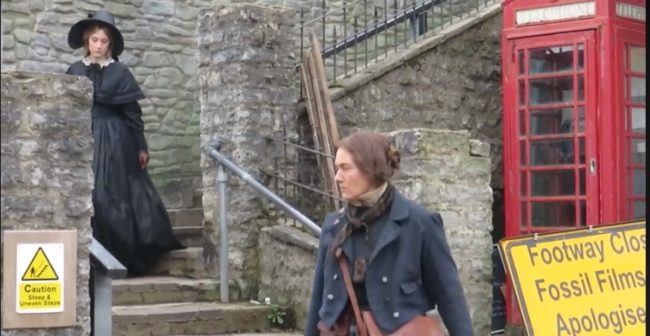Ammonite: Kate Winslet and Saoirse Ronan begin filming lesbian romance

Hollywood stars Kate Winslet and Saoirse Ronan began filming in Lyme Regis for the film Ammonite, which will feature a lesbian romance between the two. (Love Lyme Regis/Facebook)
Hollywood stars Kate Winslet and Saoirse Ronan have been spotted filming on the set of Ammonite, a lesbian period film by God’s Own Country director Francis Lee.
The small, scenic town of Lyme Regis on the West Dorset coast was given a 19th century makeover to recreate the setting in which palaeontologist Mary Anning lived and worked.
Winslet plays Anning in the lesbian period film, while Ronan plays a wealthy London woman who is advised by her husband to spend time in Lyme Regis to “get a hobby,” as the Irish actor explained in an interview with Sirius XM.
“The two develop this really beautiful, really intimate relationship,” Ronan said, also confirming that the two are lovers.
The Mary Queen of Scots star has expressed enthusiasm at acting opposite Winslet, who famously starred in Titanic, a film Ronan was obsessed with as a child.
“Who’d have thought, when I was eight years old, I’d be kissing Rose one day and I’d get to fall in love with her on a beach?” she told Irish entertainment channel Xposé in January.
Who was Mary Anning, the fossil finder played by Kate Winslet in Ammonite?
As the National History Museum wrote about the fossil finder, Anning made several important discoveries in her lifetime—her first was the 5.2 metre-long skeleton of a creature eventually named Ichthyosaurus—but her gender and her social status undermined her achievements in the eyes of Victorian society.
It wasn’t until years after her death in 1847, that she was given some long overdue credit, as recorded in a profile of Anning included in a 1865 issue of Charles Dickens’ literary magazine All The Year Round.
Anning never married and had various close friendships with women, but her portrayal as a queer woman split opinions among her descendants, with some accusing the filmmakers of embellishing Anning’s story to follow the box office and critical success of Oscar-winning film The Favourite.
In an online discussion, quoted in The Telegraph, the palaeontologist’s distant niece Barbara Anning said: “I believe if Mary Anning was gay she should be portrayed as gay and this should also be by a gay actress.
“But I do not believe there is any evidence to back up portraying her as a gay woman… I believe Mary Anning was abused because she was poor, uneducated and a woman. Is that not enough?”
She added, quoted in the Daily Mail: “The lesbian storyline is pure Hollywood as far as I know and there was no suggestion that she was a lesbian at all.”

Kate Winslet and Saoirse Ronan play lovers in Francis Lee’s new film Ammonite, based on the life of fossil finder Mary Anning. (Love Lyme Regis/Facebook)
Another descendent who lives in Australia, Julie Anning Fletcher, told The Telegraph producers were “following market trends.”
A third relative, Lorraine Anning, also spoke to the newspaper, supporting her ancestor’s portrayal in Ammonite: ‘I think it might be to make her more attractive. The fact she was a loner, an independent woman, in today’s times that could mean something different.”
When news of the film including a lesbian romance first emerged in December, it also caused a spirited discussion among the palaeontologist community.
“If this is true then its great that Mary Anning is going to get some well overdue attention, BUT the story line though? What has that got to do with Mary Anning? I feel this will totally overshadow her amazing contribution to science. Her actual story is absolutely incredible!” palaeontologist Dean R. Lomax wrote on Twitter.
“I doubt there would be this much outcry if the film featured Mary Anning in a heterosexual relationship (for which there also seems little evidence). I feel very uncomfortable with the amount of vitriol this has attracted. It may not be intentional but reads as homophobic,” palaeobiologist Sam Giles responded on the social media platform.
Giles added: “Would it really be such a terrible thing if some members of the public were left with the impression that she wasn’t heterosexual? The (?unintentional) implication is that portraying her as gay in this (fictitious) account of her life is somehow a stain on her character.”

